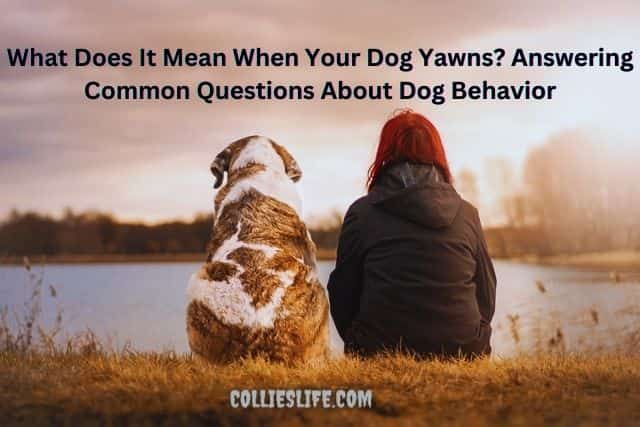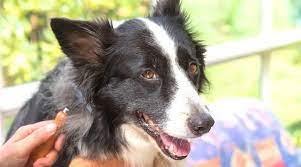What Does It Mean When Your Dog Yawns?


We all know that watching our dogs yawn can be one of the most endearing experiences of pet ownership. Watching our pup’s adorable little mouth open wide to take a big breath and then exhale slowly as they drift off to sleep is a moment of pure joy and contentment. But what does it mean when your dog yawns? Is it just a sign of tiredness, or could there be something more to your pup’s behavior? In this article, we’ll explore the different meanings behind a dog’s yawn, answering common questions about dog behavior. We’ll take a look at why dogs yawn, how to interpret their body language, and how to use this knowledge to better understand your pup’s needs and emotions. So if you’re ready to dive into the world of canine communication, let’s get started!
What is yawning in dogs? What does it mean when your dog yawns?
A yawn, for us humans, is a reflex that stretches the muscles of the face and mouth, increasing blood flow to the brain and promoting relaxation. But the “why” behind this behavior goes back millions of years. When your dog yawns, they’re temporarily rewinding time, going back to a time in the evolutionary chain when their ancestors were carnivorous reptiles. You see, reptiles don’t rely on blood vessels to bring oxygen to the brain. They depend on a specialized organ called the “Jacobsen’s organ”. This organ is sensitive to chemicals (such as carbon dioxide, nitric oxide, and nitrogen dioxide) that help regulate the heart rate and blood flow to the brain. When your dog yawns, they’re moving into “reptile mode”, and opening its mouth helps increase the flow of oxygen to its brain, enabling them to think more clearly.
What are the different types of yawning?
While there are different types of yawning in humans, in dogs, the only type of yawning we see is the stretch yawn. The stretch yawn – This is the most common type of yawning, and it’s triggered by boredom and a lack of mental stimulation. The stress yawn – This type of yawning is triggered by stress, either physical or mental. When your dog yawns when they shouldn’t be bored, or when they’re not tired, this may be a sign that they’re feeling stressed, anxious, or overstimulated. The sneeze yawn – This type of yawning is triggered by allergies, and it’s usually accompanied by a sneeze and a runny nose.
What does it mean when your dog yawns?
As we’ve already discussed, a dog yawning is a reflex that’s triggered by boredom, stress, and the need for oxygen to the brain. But there are other things to be aware of, including Your dog’s relationship with you – A yawn is often a sign of submission or a mild form of anxiety. When your dog yawns, it’s often a sign of respect for you as their leader. That’s not to say that your dog is bored with you; on the contrary, it’s often a sign of affection. When you yawn, your dog may yawn as a sign of respect for you. They’re letting you know that they’re comfortable with you and the relationship you share.
Is yawning contagious for dogs?
Interestingly, yawning is contagious for dogs, just as it is for humans. What’s even more interesting is that some dogs show a clear preference for yawning with certain people. This means that your dog may yawn as a sign of affection and respect for you, but not for your partner. If your dog is yawning in response to you yawning, you can use this to your advantage! If your dog is bored, or anxious, yawning can help them relax and let go of some of the stress and anxiety. If you’re in a position of leadership, yawning can also be a form of submission and can help your pup relax, and re-establish their relationship with you.
What other body language can indicate your dog’s emotional state?
If you’ve ever watched a dog communicate with another dog or a human, you may have noticed that they’re always doing something with their bodies. Their tails, ears, and facial expressions are always changing, and each position or movement has meaning. So what does your dog’s body language mean? When your dog’s ears are pushed back against their head, they’re feeling defensive, and they’re closing themselves off from you. When their ears are relaxed, they’re open to conversation. When their ears are down and relaxed, they’re happy, and when they’re pulled back, they’re feeling anxious.
How to interpret your dog’s behavior
As we’ve discussed, your dog’s body language and behavior can tell you a lot about how they’re feeling. But how do you interpret this and apply it to your dog? First, it’s important to be aware of what your dog’s “normal” is. Once you know what’s “normal” for your pup, you’ll be able to pick up on changes that signal when they’re feeling stressed or anxious. When you’re watching your dog, you need to keep its entire body in mind. If they’re standing straight and tall, ears relaxed, with their tail wagging, they’re probably happy to see you. But if they’re hunched over with their tail tucked between their legs and their ears pulled back, they might be feeling anxious.
How to use this knowledge to better understand your pup’s needs and emotions
Finding out what’s normal for your dog can take some time, and it can be a lot of work at first. But it’s something that can be incredibly rewarding, especially if you find yourself better equipped to help your pup with anxiety or boredom. When you understand your dog’s body language, and what it means, you can use this information to help your pup feel more comfortable and relaxed. To help your dog reduce their stress and anxiety, you can give them plenty of mental stimulation and affection, and try to reduce the amount of boredom in their day.
All about the Border collies life, health and training
Tips for monitoring your dog’s body language
If you’re interested in learning more about your dog’s body language, there are a few things you can do. Firstly, it’s important to understand that dogs use their bodies to communicate, and they’ll use different parts of their bodies at different times. This means that you need to pay attention to more than just their face. When you’re trying to understand your dog’s body language, it’s important to look at the whole picture. Don’t just focus on one part of your puppy, like its tail or ears. Take the time to look at the whole picture, and try to see what the rest of your body is doing. When you’re looking at your dog, it’s important to remember to consider the context. What is your dog doing when they’re making a certain body movement? And are they doing it because they want to approach you, or because they want to avoid you?
Conclusion
There’s nothing as adorable as seeing a dog yawn. But understanding what it means can be incredibly helpful, especially if your dog is feeling anxious or if they’re feeling bored. By learning what your dog’s body language means, you can better understand their feelings, and you can use this information to help your pup feel more comfortable and relaxed. But, most importantly, you can use this knowledge to strengthen your relationship with your pup. When you take the time to understand your dog, and what they’re feeling, you’ll be better equipped to help them with its needs and emotions.





